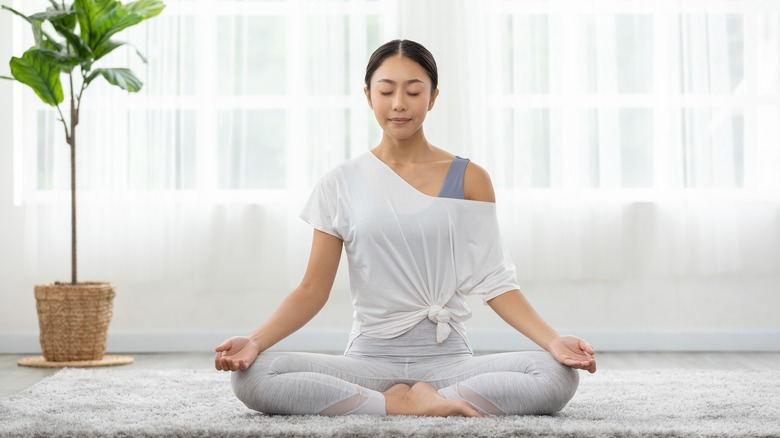Tips For Setting Wellness Intentions
In today's world, when you hear the words "wellness" and "intentions" there are likely a hundred different things that come to mind, from the trendiest type of yoga at the moment to a recently read recipe of essential oils marketed to create positive change. There is no doubt that the modern wellness industry is a major player in the global market, with a 2021 survey by McKinsey & Company determining that the industry is worth over $1.5 trillion. The high value of the wellness industry may seem staggering, but the reasons why people seek out wellness practices come down to six simple categories, which are the pursuit of better health, sleep, nutrition, fitness, appearance, and mindfulness. There are overarching themes of wanting to feel calmer, be healthier, and have more energy so that being present and engaged in the current moment can be achieved. To successfully obtain these goals, the first step is to set intentions for your wellness practice.
A wellness practice is a set of goals and habits that prioritize both physical and mental health, which are intrinsically linked, according to Rhodes College. Wellness comes in many forms, including physical, spiritual, occupational, social, emotional, environmental, cultural, and intellectual. When one area of your life is impacted, it's likely that other areas will be affected, too. That is why it's important to prioritize a wellness practice that makes you feel your all-around best. Here's how to start your wellness journey by creating and setting intentions for a quality practice.
Decide who you want to be
When setting wellness intentions, try to center your goals around becoming the person you wish to be. Maybe you want to be more confident, a better friend or partner, conscious of the food you put into your body, or any number of visualizations that can become reality. When you set intentions, you are laying the groundwork for becoming the person you want to be, per SoulKu. Or perhaps you're already happy with who you are, in which case your wellness practice may center around strengthening the qualities and habits you want to focus your energy on. A quote by Jack Kornfield says, "Intention leads to behaviors, which leads to habits, which leads to personality development, which leads to destiny." While destiny may seem as large and looming as the universe itself, starting small with wellness intentions can lead to positive changes in your behaviors and habits that you may be surprised to see happen sooner than expected with the right mindset in place.
To determine your intentions for your wellness practice and personal growth, give the S.M.A.R.T. method a go (via Integris Health). Set intentions that are specific, measurable, attainable, realistic, and time specific. For example, you could decide that you want to be a better friend to strengthen your social wellness, and following the S.M.A.R.T. method you might aim to write one handwritten note to a friend each week using stationery placed on your desk.
Practice your pillars
Similar to determining your goals, ambitions, and desires for your wellness journey and personal growth, you should create pillars of your overall wellness path that you can return to when you feel like you've stepped away from your practice. The pillars of your wellness practice are your values and foundation, which are rooted in your intentions. To determine your pillars, set intentions for your practice that you can reasonably transform into achievable habits, then practice those habits to bask in the remarkable changes intentions can create in your life.
Without intentions or pillars to guide you, your time and pursuits may slip away from you and things around you may determine your mood and achievements. With intentions, you can garner control over the direction of both your wellness practice and your overall life. The number of pillars you have in your wellness practice is up to you, but make certain that your intentions remain attainable and don't become overwhelming in feeling like yet another requirement you must complete. Your pillars should make you feel excited about your wellness practice and guide you in becoming the best version of yourself. For example, your pillars could be compassion, social connection, and gratitude. In this case, your intentions and goals might be to volunteer your time to help others and express gratitude in the process. To keep things simple, it may be easiest to start with one pillar and add more as your confidence in your practice strengthens.
Manifest with a mantra
To condense your wellness practice's pillars, having a mantra that you repeat when it comes to practicing your wellness routine can help you remember your intentions and bring you back to a place of feeling centered and connected with why you've chosen your practice. Your mantra can be used interchangeably with an affirmation, which carries benefits including reducing anxiety, aiding in effective problem-solving, warding off negative thought patterns, and boosting mood, self-esteem, motivation, and optimism (via Healthline). Examples of affirmative mantras are, "I am a kind person who practices compassion" and "Things will be okay because I'm taking one step at a time." Similar to the S.M.A.R.T. method of setting intentions and goals, your mantra should be realistically attainable. Creating your mantra is as unique as you are, so personalize your wording to the intentions you have for your own wellness practice. Tips for deciding on an affirmative mantra include beginning the phrase with "I" or "My" and wording it in the present tense. You can even include intentions you wish to embrace such as, "I feel anxious, but I'll become calmer through my breathing practice."
One way to reinforce your mantra is through the practice of mantra meditation, which is when you utilize your mantra in a meditative state wherein repeating your mantra over and over again can help bring self-awareness and presence in the current moment. Start with a few minutes of deep breathing and silent repetition of your mantra.
Be compassionate with yourself
As you embark on your wellness journey and set your intentions, keep in mind that this is a practice and that means that it will take time to learn. You won't be perfect in your wellness practice or in following your intentions every moment of every day, and that is absolutely okay. One important component to have alongside your wellness intentions is self-compassion, which means being kind to yourself and appreciating the progress you're making even if it isn't as far along as you'd hoped. Unlike self-esteem and confidence, self-compassion is the acceptance of yourself with all of your mistakes, mishaps, and blemishes thrown into the mix. Loving yourself because you're trying your best and offering yourself the grace to spend a day lounging on the couch instead of pressuring yourself to tackle household chores or other projects is the practice of self-compassion. Plus, that day spent lounging will give you the opportunity to relax and recharge needed for your overall wellness. Additional benefits of self-compassion include increased resilience, sense of worth, emotional intelligence, social relationships, motivation, and general satisfaction while offering decreased depression, anxiety, stress, and fear of failure.
Wellness intentions should be set in self-compassion, per The Healthy. To emphasize, goals are typically set in making corrections with the approach that one's current status isn't good enough, while intentions focus on your mindset, self-love, and journey to embracing pillars that are personally important.
Prioritize joy over pressure and guilt
Building on self-compassion, prioritize the enjoyment of embracing your intentions each day over any perceived pressure to achieve your wellness aspirations or guilt for temporarily straying from your intentions. Placing pressure on yourself will likely have the opposite effect of self-compassion, so when you set your wellness intentions make a promise to yourself that you will pursue your intentions from a place of joy and self-love while rejecting self-imposed pressure, guilt, and other negative thought patterns. You might feel the need to seek perfectionism in your wellness journey, so to counteract this mindset you can put into place a mantra rejecting perfectionism at the same time as you set your intentions. You can try something as simple as, "I don't have to be perfect" or elongate it with, "I don't have to be perfect. I won't expect that of myself any longer."
Wellness is about improving your health in all realms of your life, and placing stress-inducing pressure or guilt on yourself will ultimately harm your pursuit of wellness. Healthline advises that self-punishment can come in numerous forms that fall on a spectrum, but the outcome is similar in that it places self-imposed harm on oneself in some capacity. Whether self-punishment manifests as an internal lecture, reliving bad memories, or reprising negative feelings, the act takes a toll and is likely to cause more distress. Instead of guilt, try an affirmative mantra like, "I'll do better next time."
Practice self gratitude
The opposite of self-punishment is the practice of self-gratitude, which can have a plethora of positive benefits on your wellness practice and general well-being. When you set wellness intentions, make a sidenote to express gratitude to yourself for each intention you successfully pursue each day, but also for your commitment to your wellness journey and trying your best in the spirit of self-compassion. There are many ways to embrace gratitude, such as writing in a gratitude journal, expressing your gratitude verbally, writing thank you letters, saying prayers, or through means of your choosing. You can express gratitude for yourself, others, or the world around you. There are endless things to be grateful for, which makes the practice of gratitude exhilarating with unending possibilities. You don't have to take on grand gestures to carry out gratitude as the practice of being grateful can be as simple as taking the time to notice something you appreciate in your surroundings. When it comes to expressing gratitude for yourself and your progress on your wellness journey, an act of self-gratitude could be as uncomplex as merely acknowledging that you're doing your very best to commit to your wellness intentions.
Gratitude will only strengthen your wellness by improving physical and mental health, leading to more friendships and authentic relationships, and increasing empathy for oneself and others, per Psychology Today. In the wellness sphere, regularly expressing gratitude can lead to both better sleep and higher self-esteem.
Embrace the journey
After setting your wellness intentions, actionable steps, foundational pillars, crafting an affirmative mantra, letting go of pressure and guilt, and incorporating gratitude, remember that your wellness practice is a journey. With self-compassion in mind, remind yourself that your journey won't be a perfectly straight line, but it will have twists and turns. Extend compassion and gratitude to yourself as you carry out the practice of centering yourself in your pillars, repeating your mantra to yourself, and working on letting go of self-punishment.
Columbus Monthly offers the advice that a wellness journey should include self-care, which ultimately brings you back to being grounded in wellness itself. From exercising to sitting in quiet solitude to visiting places with which you have a spiritual connection, doing things that make you feel connected to yourself will help you along your wellness journey. When setting wellness intentions, take into account the journey you want to go on and what types of self-care make you feel your best. Perhaps you want your journey to include better sleep hygiene or you desire to gain perspective through trying a practice like yoga or reiki. To sleep better, you can set an intention to turn all electronic screens off half an hour before you go to bed. To embrace a wellness journey rooted in gaining perspective, you can set an intention to attend a weekly yoga class or try a virtual yoga workout. Create intentions individualized for your journey.







